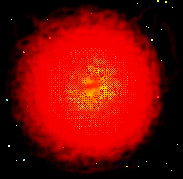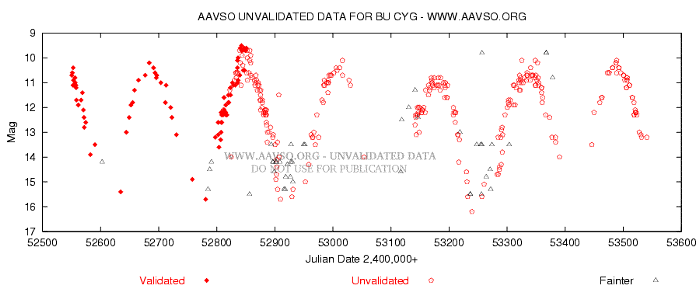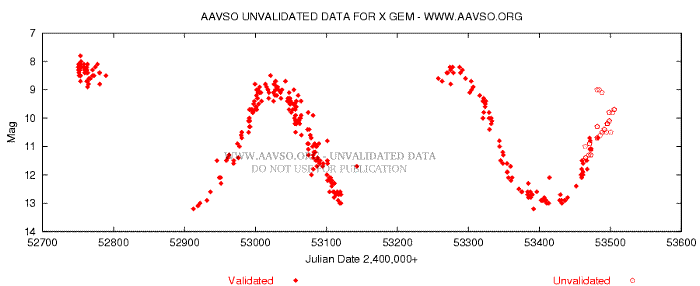S Leonis Minoris - BU Cygni - BB Cassiopeiae - FN Orionis - X Geminorum - W Herculis - PQ Cephei
These are A Few of My Favourite Miras
 Mira stars, or Long-Period Variables, are among the most numerous of all variable stars. They are all pulsating stars of spectral types M through S; that is, red star. They are old as stars go, very near the end of their stellar careers. Traditionally, they have been the backbone of the amateur astronomer's observing programme due to their gradual light changes and large amplitudes (ranges of variation), and, though the current fashion among advanced amateurs has now shifted to the more unpredictable Cataclysmic Variables (sexy name, huh?) there are still some interesting experiences to be had with the Mira variables - witness the recent AAVSO colloquium on these stars.
Mira stars, or Long-Period Variables, are among the most numerous of all variable stars. They are all pulsating stars of spectral types M through S; that is, red star. They are old as stars go, very near the end of their stellar careers. Traditionally, they have been the backbone of the amateur astronomer's observing programme due to their gradual light changes and large amplitudes (ranges of variation), and, though the current fashion among advanced amateurs has now shifted to the more unpredictable Cataclysmic Variables (sexy name, huh?) there are still some interesting experiences to be had with the Mira variables - witness the recent AAVSO colloquium on these stars.
Here then is a personal trawl through my favourite Mira Stars; some you may be familiar with, others you won't. Nearly all of these stars can be followed with charts available from the AAVSO. One of these stars, PQ Cephei, is a recent discovery, and so far the only way I know of obtaining a chart is through me, though I believe the AAVSO have now taken it to their collective bosom.
Leo minor is a dull, boring group of fourth-magnitude stars, a kind of cosmical William Hague; but this neat little Mira star is good to observe. It has a period of 234 days, so one observation every three weeks is sufficient to follow its changes, which range between magnitudes 8 and 14. It is in the same field as another Mira, U LMi, and furthermore is right next to a bright star of magnitude 7.0. The AAVSO (d) scale chart is great for S Limmy, which is one of those stars which seems to have been put there for the benefit of VS observers; easy to find, with well-arranged comparison stars. The light-curve below, showing observations of this star over the last 5 years shows that this is a typical member of the class.

BU Cygni
It's in Cygnus, so you get the added attraction of beautiful star-fields too. Actually this is one of the things which, as a raw youth of about twelve, first drew me towards Variable Stars. I'm afraid that, to this day, my abiding memory of Jupiter is not the Great Red Spot (I've never seen it!) nor even the Shoemaker-Levy crash, but the fact that it kept getting in the way of SY Cancri, a particularly nice eruptive variable.
Like many of my favourite Miras, BU Cyg has quite a short period, 158 days in this case, and is fairly easy to find near a brilliant group of tenth-magnitude stars, themselves close to another band of even brighter ones. Apologies to anyone who thinks you can't talk about 10m stars being 'brilliant' but believe me they are in a 36cm Mirror, now that I've had the flat redone. Again, as we often find with the short-period LPV's, there tends to be a wide divergence between successive maxima/minima, and this is what hit me about BU Cyg the first time I watched it fall. Its official minimum is supposed to be 14.5, but once I saw it at magnitude 16.0 and again at 16.1, so I think a few figures are going to need changing there if this keeps up. In fact in August 2001 I made my faintest-ever observation of a variable star, estimating BU Cyg at magnitude 16.5!

I often couple observations of this star with another of my favourites, Z Cyg. This is probably my all-time fave Mira, not for any deep astrophysical reason, but just because it was the first VS estimate I made with my spanking new 14" Dobsonian in 1991. Oh, those star colours were a revelation! Actually, there is a third Mira in this field, BT Cyg, a much fainter star varying between photographic magnitudes 12 and fainter than 16. Since photo mags are fainter than visual ones for red stars, the maximum should be about magnitude 10.5 visual. However, I often record BT at magnitude 15 and above.
BB Cassiopeiae
I like this variable for two reasons; first, it is in a cute group of faint stars, and second, it is poorly-observed, so is in need of observing by folks such as you (hopefully!) and I. It is a faint star, varying between 12.7 and 16.6 (pg magnitude; - nearly all these faint variables are neglected visually). Easily found near the bright star 6 Cas in a field which is noticeably dark - maybe there are dark nebulae here - it lies within a beautiful little group of 11th- to 14th-magnitude stars and has a period of about 11 months with a peculiar light-curve insofar as the rise to maximum is noticeably slower than the fall, as you can see. This is a pretty interesting, if challenging, star to observe. Anyway, I like it.

FN Orionis
This is another Mira star with a short period, only 118 days, with a photographic range of 11 to <13 mags. It lies midway between two stars of 12.5 and 14.0m and forms a neat little isosceles with two more; these two are in turn the base of another isosceles, the whole package lying between a pair of 7m stars and a brilliant little 8th-9th magnitude group readily visible in binoculars, and right on the celestial equator. As befits its short period, FN Ori shows a rapid rise and fall, as the light curve shows, though it could be better-observed.
I use an AAVSO (d) scale chart for this star, which could do with some fainter comparisons. Observe it once a fortnight to see its changes. It is quite close to a faint eruptive variable of the Z Camelopardalis type, BI Ori, and I tend to drift from one to the other, though BI, being a cataclysmic star, needs observing on every possible occasion.

X Geminorum
Webb's Cycle of Celestial Objects (I have the 1917 edition, nicely used by now, having found it in an antiquarian bookshop one Christmas) tells us that this was discovered by one Anderson. Could this be the same Anderson who discovered the famous nova in Perseus, GK Per, in 1901, and which still bears looking at today?
I like X Gem because it is so beautifully surrounded with little stars, curiously all 0.2m apart from each other - 12.8, 13.0, 13.2, 13.4, 13.6! It can be a bit difficult to find at first. The best guide is a large, bright diamond of 5 - 6m stars a few degrees to the North of epsilon Gem.
The range is some 5 magnitudes and the period 264 days, so you do get some good ammunition for your own light-curve! That below shows typical behaviour over an 800-day period.

W Herculis
This was one of the first telescopic variables I ever observed, and it has the added advantage of being near the Hercules Cluster. Sometimes, you know, us VS observers can get a bit serious about our science and forget all the wonderful things in the sky that we can just look at - like M13, so use this star as an excuse to have a look at the cluster, should you need one.
Anyway, W Her is a really nice star to look at, tucked away there in its little back-to-front Y of comparison stars and surrounded by two or three fainter ones. A small telescope can follow this star through a lot of its cycle. As you can see from the light-curve below, the rise to maximum has about the same gradient as the fall to minimum.

PQ Cephei
When I'm not observing variable stars, I'm making charts for new ones, usually unobserved Miras, nebulars, or RV Tau stars. I found this recent discovery in the GCVS, and I am astonished that it went unnoticed for so long. But its case is similar to that of another new discovery, the bright mira V666 Cas (the artist formerly known as DHK-1). PQ Cep is even brighter, and so red I'm astounded that it wasn't swept up by Espin or Webb or one of those victorian red-star hunters, though it is rather isolated in a kind of no-star's land. But boy is it red!
As far as I know, I am the only person observing this object, and for the few months that I have watched it so far, it has hovered around magnitude 9.2 - 9.6 (estimates are not too easy due to its deep red colour), but since these words were originally written, it has been adopted by the AAVSO, so you should use their chart rather than the one I provided on the first incarnation of the website.
The star is not too difficult to find from a most distinctive group of 5m stars just North of beta Cephei, an area rich in interesting variables, chiefly nebular stars. Notice that there is usually a hump on the rise to maximum, and that this rise is often slightly slower than the fall, which is fairly uncommon amongst Mira stars.

Back to main Variable Star page...
 Mira stars, or Long-Period Variables, are among the most numerous of all variable stars. They are all pulsating stars of spectral types M through S; that is, red star. They are old as stars go, very near the end of their stellar careers. Traditionally, they have been the backbone of the amateur astronomer's observing programme due to their gradual light changes and large amplitudes (ranges of variation), and, though the current fashion among advanced amateurs has now shifted to the more unpredictable Cataclysmic Variables (sexy name, huh?) there are still some interesting experiences to be had with the Mira variables - witness the recent AAVSO colloquium on these stars.
Mira stars, or Long-Period Variables, are among the most numerous of all variable stars. They are all pulsating stars of spectral types M through S; that is, red star. They are old as stars go, very near the end of their stellar careers. Traditionally, they have been the backbone of the amateur astronomer's observing programme due to their gradual light changes and large amplitudes (ranges of variation), and, though the current fashion among advanced amateurs has now shifted to the more unpredictable Cataclysmic Variables (sexy name, huh?) there are still some interesting experiences to be had with the Mira variables - witness the recent AAVSO colloquium on these stars.





